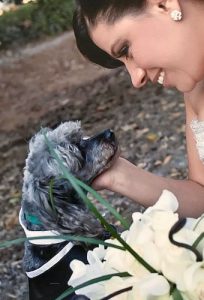Must Love Dogs by Dr. Maythee Rojas
 Dogs are such a big part of Maythee Rojas’ life that when she got married, her dog Nacho served as ringbearer.
Dogs are such a big part of Maythee Rojas’ life that when she got married, her dog Nacho served as ringbearer.
Must Love Dogs
Published: September 18, 2017
By Shayne Schroeder
For full disclosure, Maythee Rojas loves dogs.
“I adore them,” said Rojas, a professor of Chicano and Latino Studies at CSULB. “Dogs have always been a huge part of my life.”
They are such a part of her life, in fact, that she is working on a book that combines two of the literary scholar’s passions—storytelling and dogs.
Cultura Canine is a social analysis of the interactions between dogs and Latino communities in the United States. The cultural studies project will cover topics that range from examining the racialized policing of Latinos and animal welfare in Los Angeles County to tracing the presence of canine imagery in Chicano literature to profiling the once-undocumented celebrity dog trainer, Cesar Milan.
In particular, the book examines how immigration and acculturation have impacted Latino dog ownership.
“I’m in the early stages of writing this book, but I’ve been planning it for several years,” she said. “I want to develop a series of interconnected essays that discuss the cultural differences around caring for dogs as well as consider how canines are used both metaphorically and literally to comment on the treatment of Latino communities in the U.S.”
Drawn by the power of narrative, Rojas grew increasingly interested in stories that detailed how and why Latinos own certain dogs, what the histories of these relationships are and how those relationships are interpreted within sociopolitical contexts.
One of the book’s main chapters will deal with the acculturation of Latinos, observing that as these populations move in larger numbers to the United States, there is a natural blending of cultures.
“They become hyphenated, where they are Mexican, but also American; where they are Costa Rican, but also American,” said Rojas. “Acculturation has so many levels to it and one of it is your family’s day-to-day practices. Americans spend more on their pets than any other nation, and we’re seeing that trend also growing within Latino communities.”
She referenced a recent marketing profile that indicated Latino ownership of animals is on the rise, particularly among Latino millennials.
“So, I am interested in writing about the development of these communities as they move into a more middle class environment where they are adopting more middle class habits, which includes dog ownership.
“But there are things Latinos still keep from within their culture that influences how they ‘parent’ their dogs,” she added. “For example, the names they give them. They aren’t names like Spot or Butch, but more like Chuy or Lola. There is also a stereotype out there that Latinos don’t often care for their dogs as they should. That they don’t vaccinate them, that they let them wander the streets or keep them tied up, that there is a lot of abuse. I took issue with that.
“I want to address some of these misconceptions,” she continued. “Not necessarily to dispel them because animal cruelty, sadly, exists in all cultures, but I think Latinos are loving dogs in ways that haven’t been recognized before, while still keeping those dogs culturally ‘Latino.’ For example, my dogs are bilingual.” She, of course, was joking.
Rojas, a Latina, has a personal connection that drives this project. The loss of her 13-year-old poodle-terrier companion, Nacho, four years ago was very hard, but she now feels the distance allows her to better address the material.
Rojas said she would end the book with a chapter on grieving and spirituality–another topic that has historical roots around how Latinos have respected animal life, including dogs. She cited the yearly Blessing of the Animals event on downtown L.A.’s Olvera Street as an example.
“This chapter will definitely be framed around my own loss of Nacho, which was very painful, but I also want to honor Nacho for all that he taught me. This book gives a place for me, as the author, to combine a very meaningful part of my own life with a more broader examination of the cultural and sociopolitical shifts surrounding U.S. Latino culture.”
